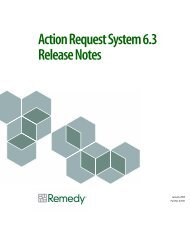BMC Remedy Action Request System 7.6.04: BMC Remedy Mid Tier ...
BMC Remedy Action Request System 7.6.04: BMC Remedy Mid Tier ...
BMC Remedy Action Request System 7.6.04: BMC Remedy Mid Tier ...
Create successful ePaper yourself
Turn your PDF publications into a flip-book with our unique Google optimized e-Paper software.
Export file formats for AR <strong>System</strong> reports<br />
If Inactive or Pending is selected, the report does not appear the Report Console<br />
list.<br />
Export file formats for AR <strong>System</strong> reports<br />
AR Export format<br />
AR XML format<br />
You can save or export AR <strong>System</strong> data to use in AR <strong>System</strong> forms, in a<br />
spreadsheet, or in other applications. You can also save or export non-AR <strong>System</strong><br />
data from another application to use in an AR <strong>System</strong> form.<br />
The file formats that you choose for exporting depend on the original data source<br />
and how you will use the data. File formats for AR <strong>System</strong> reports are explained in<br />
the following sections.<br />
AR Export (.arx) is the default file type. It yields the cleanest results when data is<br />
exported and imported within AR <strong>System</strong>. The AR Export format properly<br />
formats data that you import into an AR <strong>System</strong> form by using <strong>BMC</strong> <strong>Remedy</strong> Data<br />
Import.<br />
NOTE<br />
When an attachment is exported in AR Export format from a browser, a .zip file<br />
is created that includes the .arx file and the attachments.<br />
AR XML (.xml) is a <strong>BMC</strong> <strong>Remedy</strong> XML standard derived from the W3C XForm<br />
standard, and it contains several elements that are required for AR <strong>System</strong> use. To<br />
import XML data into an AR <strong>System</strong> form by using <strong>BMC</strong> <strong>Remedy</strong> Data Import,<br />
your data must conform to the AR XML data specification. Data exported to the<br />
AR XML file type conforms to this specification. You can also convert XML data<br />
obtained outside AR <strong>System</strong> to the AR XML standard.<br />
Conversely, you can export AR XML data, parse it with any tool that parses<br />
documents that conform to the XForm specification, and use the data outside<br />
AR <strong>System</strong>. For information about XForms, see the W3C website.<br />
Attachments are handled in the same manner as in the .arx file type.<br />
NOTE<br />
When you export AR <strong>System</strong> data from Crystal Reports to HTML 3.2, HTML 4.0,<br />
or XML, your default export directory depends on whether your computer is<br />
connected to a network. If your computer is connected to a network, and your<br />
login profile has a temporary directory setting under Windows, your default<br />
export directory will be %USERPROFILE%\LocalSettings\Temp. If your computer<br />
is not connected to a network your export will default to whatever temporary<br />
directory is set in your Windows environment settings, for example, C:\Temp or<br />
C:\Windows\Temp.<br />
Appendix C For your end users: Creating reports in a browser 183





